Dissertation: Employee Satisfaction in Public and Private Sectors
VerifiedAdded on 2023/04/20
|35
|9263
|373
Thesis and Dissertation
AI Summary
This dissertation, a literature review and research methodology, investigates the factors influencing employee satisfaction, commitment, and performance, comparing the Guyana National Bureau of Standards (GNBS) with the private sector. It explores key concepts such as employee satisfaction, defined through various factors including work conditions, career growth, and company policies. The study delves into motivational theories like Maslow's hierarchy of needs and Herzberg's two-factor theory, alongside the Job Characteristics Model by Hackman and Oldham, to understand the drivers of employee satisfaction. The research also critically evaluates employee commitment and performance, examining how these elements are interconnected. It emphasizes the importance of factors such as teamwork, office environment, and performance appraisal systems on overall organizational success. The dissertation aims to identify how organizations can enhance employee satisfaction, commitment, and performance to improve productivity and achieve organizational goals.
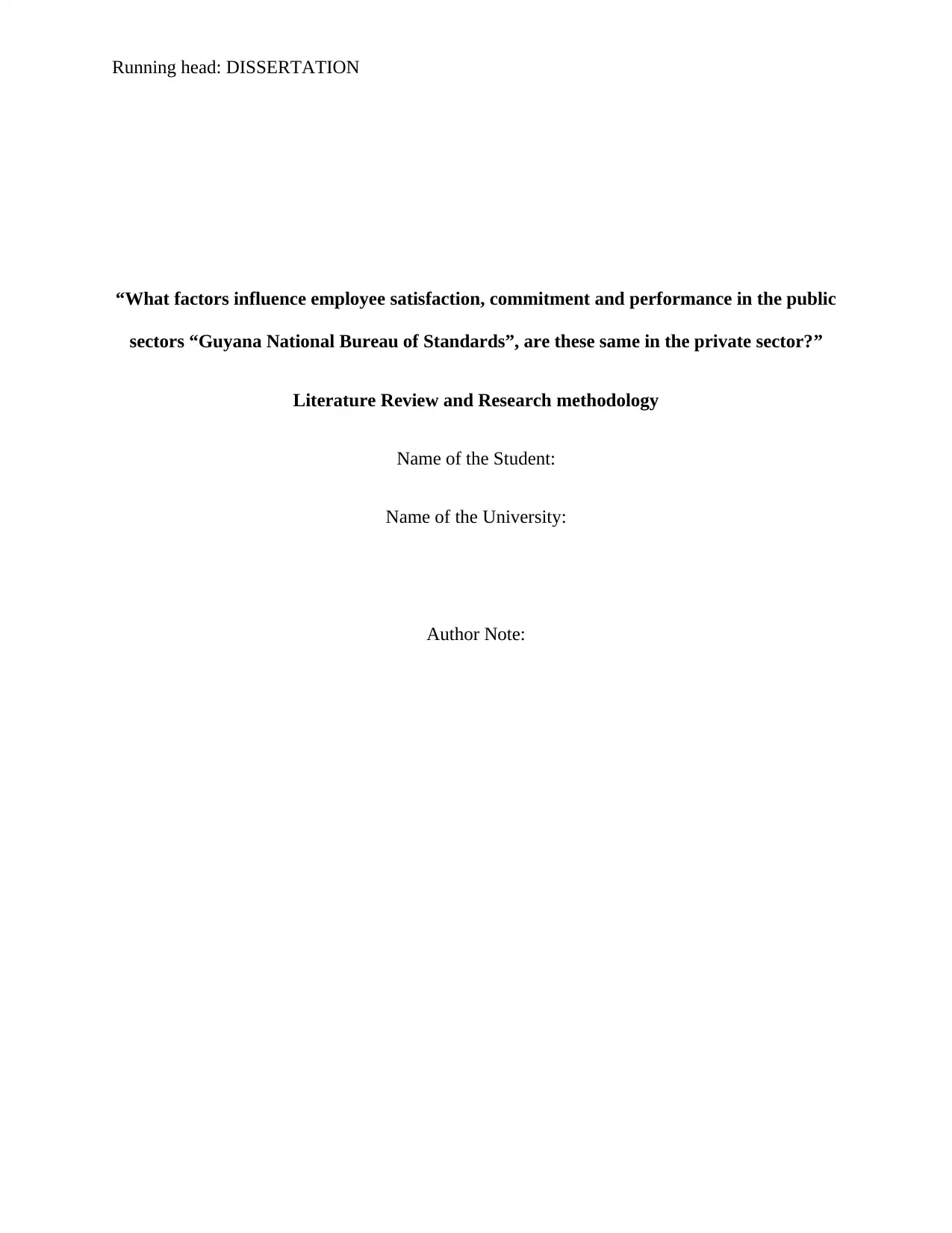
Running head: DISSERTATION
“What factors influence employee satisfaction, commitment and performance in the public
sectors “Guyana National Bureau of Standards”, are these same in the private sector?”
Literature Review and Research methodology
Name of the Student:
Name of the University:
Author Note:
“What factors influence employee satisfaction, commitment and performance in the public
sectors “Guyana National Bureau of Standards”, are these same in the private sector?”
Literature Review and Research methodology
Name of the Student:
Name of the University:
Author Note:
Paraphrase This Document
Need a fresh take? Get an instant paraphrase of this document with our AI Paraphraser
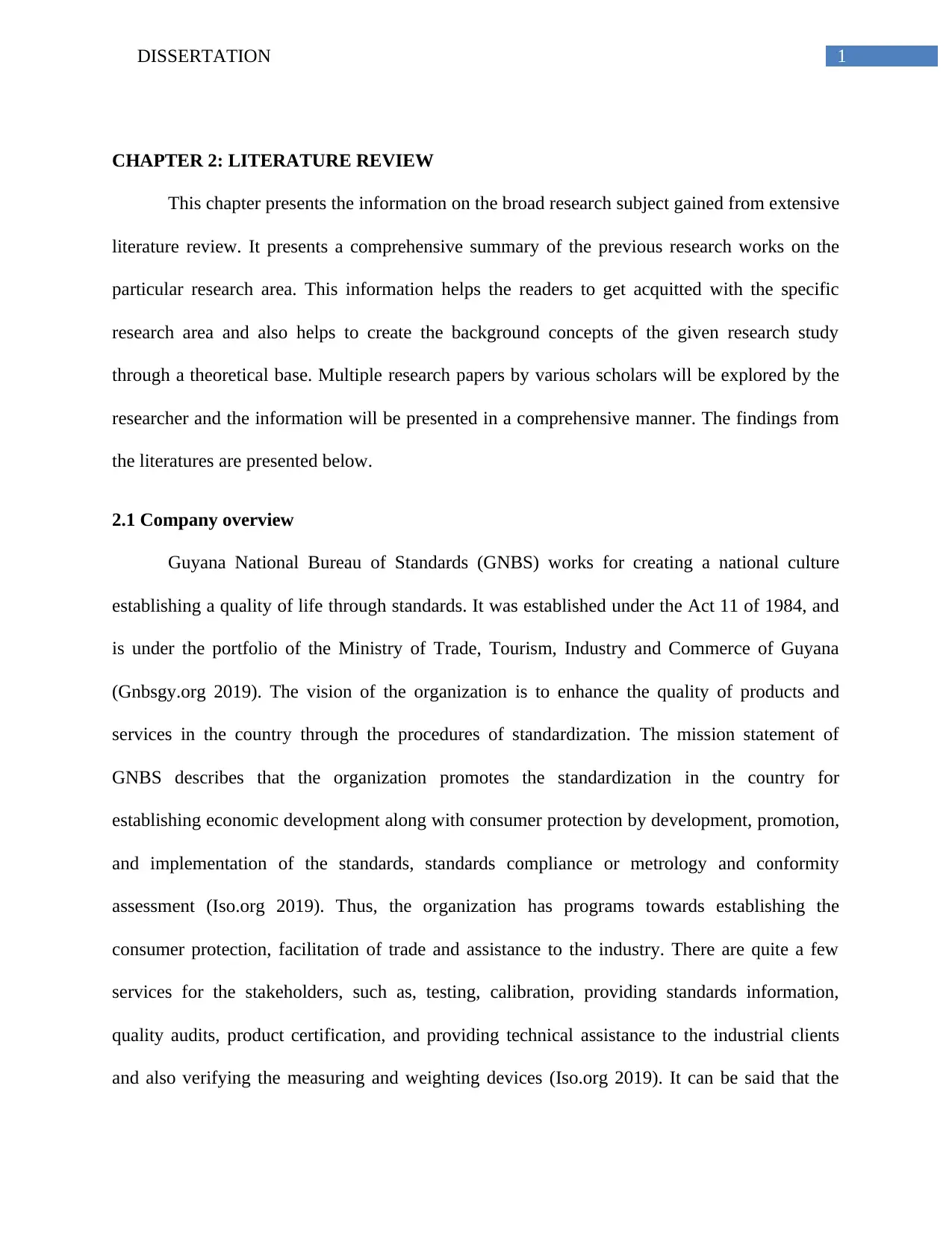
1DISSERTATION
CHAPTER 2: LITERATURE REVIEW
This chapter presents the information on the broad research subject gained from extensive
literature review. It presents a comprehensive summary of the previous research works on the
particular research area. This information helps the readers to get acquitted with the specific
research area and also helps to create the background concepts of the given research study
through a theoretical base. Multiple research papers by various scholars will be explored by the
researcher and the information will be presented in a comprehensive manner. The findings from
the literatures are presented below.
2.1 Company overview
Guyana National Bureau of Standards (GNBS) works for creating a national culture
establishing a quality of life through standards. It was established under the Act 11 of 1984, and
is under the portfolio of the Ministry of Trade, Tourism, Industry and Commerce of Guyana
(Gnbsgy.org 2019). The vision of the organization is to enhance the quality of products and
services in the country through the procedures of standardization. The mission statement of
GNBS describes that the organization promotes the standardization in the country for
establishing economic development along with consumer protection by development, promotion,
and implementation of the standards, standards compliance or metrology and conformity
assessment (Iso.org 2019). Thus, the organization has programs towards establishing the
consumer protection, facilitation of trade and assistance to the industry. There are quite a few
services for the stakeholders, such as, testing, calibration, providing standards information,
quality audits, product certification, and providing technical assistance to the industrial clients
and also verifying the measuring and weighting devices (Iso.org 2019). It can be said that the
CHAPTER 2: LITERATURE REVIEW
This chapter presents the information on the broad research subject gained from extensive
literature review. It presents a comprehensive summary of the previous research works on the
particular research area. This information helps the readers to get acquitted with the specific
research area and also helps to create the background concepts of the given research study
through a theoretical base. Multiple research papers by various scholars will be explored by the
researcher and the information will be presented in a comprehensive manner. The findings from
the literatures are presented below.
2.1 Company overview
Guyana National Bureau of Standards (GNBS) works for creating a national culture
establishing a quality of life through standards. It was established under the Act 11 of 1984, and
is under the portfolio of the Ministry of Trade, Tourism, Industry and Commerce of Guyana
(Gnbsgy.org 2019). The vision of the organization is to enhance the quality of products and
services in the country through the procedures of standardization. The mission statement of
GNBS describes that the organization promotes the standardization in the country for
establishing economic development along with consumer protection by development, promotion,
and implementation of the standards, standards compliance or metrology and conformity
assessment (Iso.org 2019). Thus, the organization has programs towards establishing the
consumer protection, facilitation of trade and assistance to the industry. There are quite a few
services for the stakeholders, such as, testing, calibration, providing standards information,
quality audits, product certification, and providing technical assistance to the industrial clients
and also verifying the measuring and weighting devices (Iso.org 2019). It can be said that the
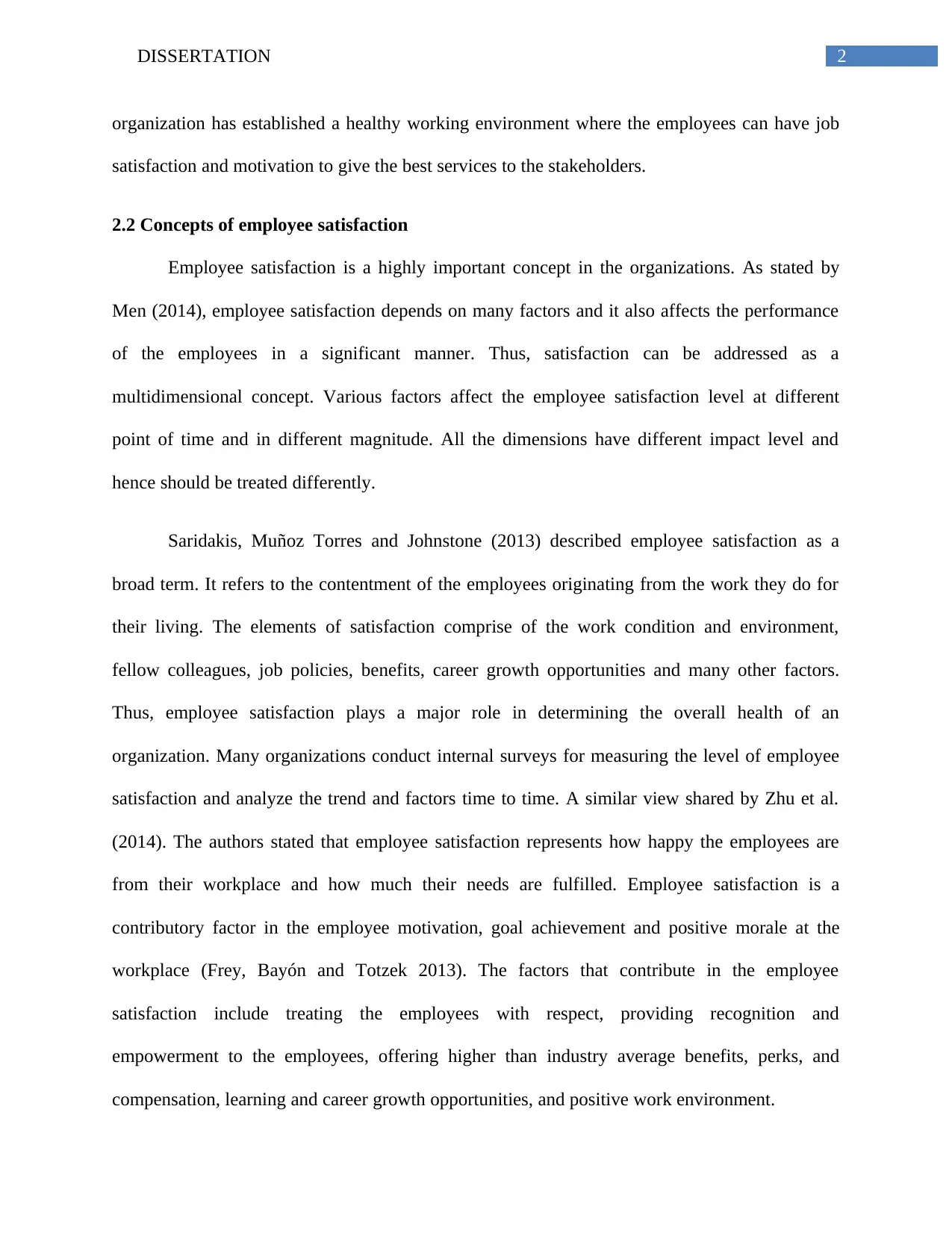
2DISSERTATION
organization has established a healthy working environment where the employees can have job
satisfaction and motivation to give the best services to the stakeholders.
2.2 Concepts of employee satisfaction
Employee satisfaction is a highly important concept in the organizations. As stated by
Men (2014), employee satisfaction depends on many factors and it also affects the performance
of the employees in a significant manner. Thus, satisfaction can be addressed as a
multidimensional concept. Various factors affect the employee satisfaction level at different
point of time and in different magnitude. All the dimensions have different impact level and
hence should be treated differently.
Saridakis, Muñoz Torres and Johnstone (2013) described employee satisfaction as a
broad term. It refers to the contentment of the employees originating from the work they do for
their living. The elements of satisfaction comprise of the work condition and environment,
fellow colleagues, job policies, benefits, career growth opportunities and many other factors.
Thus, employee satisfaction plays a major role in determining the overall health of an
organization. Many organizations conduct internal surveys for measuring the level of employee
satisfaction and analyze the trend and factors time to time. A similar view shared by Zhu et al.
(2014). The authors stated that employee satisfaction represents how happy the employees are
from their workplace and how much their needs are fulfilled. Employee satisfaction is a
contributory factor in the employee motivation, goal achievement and positive morale at the
workplace (Frey, Bayón and Totzek 2013). The factors that contribute in the employee
satisfaction include treating the employees with respect, providing recognition and
empowerment to the employees, offering higher than industry average benefits, perks, and
compensation, learning and career growth opportunities, and positive work environment.
organization has established a healthy working environment where the employees can have job
satisfaction and motivation to give the best services to the stakeholders.
2.2 Concepts of employee satisfaction
Employee satisfaction is a highly important concept in the organizations. As stated by
Men (2014), employee satisfaction depends on many factors and it also affects the performance
of the employees in a significant manner. Thus, satisfaction can be addressed as a
multidimensional concept. Various factors affect the employee satisfaction level at different
point of time and in different magnitude. All the dimensions have different impact level and
hence should be treated differently.
Saridakis, Muñoz Torres and Johnstone (2013) described employee satisfaction as a
broad term. It refers to the contentment of the employees originating from the work they do for
their living. The elements of satisfaction comprise of the work condition and environment,
fellow colleagues, job policies, benefits, career growth opportunities and many other factors.
Thus, employee satisfaction plays a major role in determining the overall health of an
organization. Many organizations conduct internal surveys for measuring the level of employee
satisfaction and analyze the trend and factors time to time. A similar view shared by Zhu et al.
(2014). The authors stated that employee satisfaction represents how happy the employees are
from their workplace and how much their needs are fulfilled. Employee satisfaction is a
contributory factor in the employee motivation, goal achievement and positive morale at the
workplace (Frey, Bayón and Totzek 2013). The factors that contribute in the employee
satisfaction include treating the employees with respect, providing recognition and
empowerment to the employees, offering higher than industry average benefits, perks, and
compensation, learning and career growth opportunities, and positive work environment.
⊘ This is a preview!⊘
Do you want full access?
Subscribe today to unlock all pages.

Trusted by 1+ million students worldwide
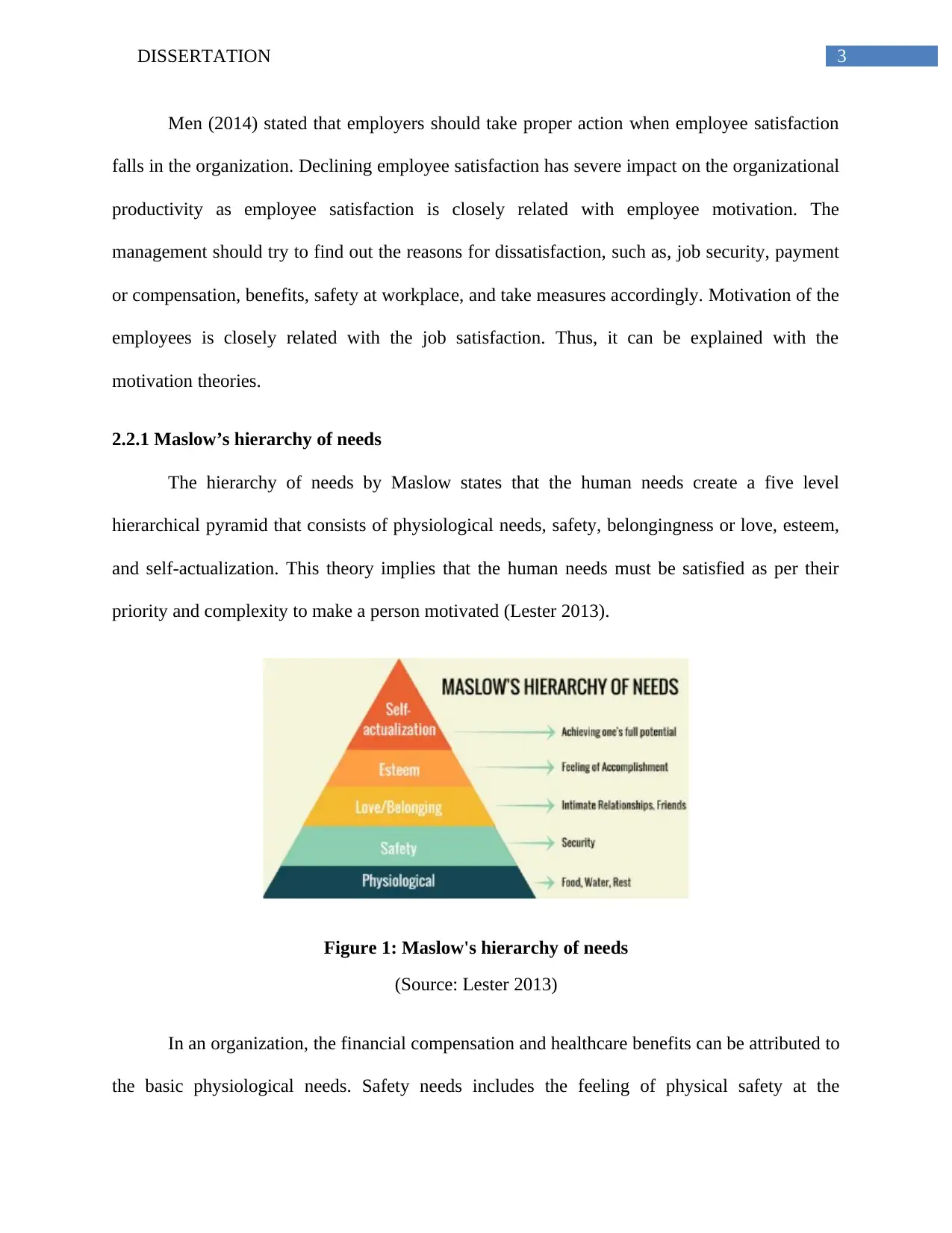
3DISSERTATION
Men (2014) stated that employers should take proper action when employee satisfaction
falls in the organization. Declining employee satisfaction has severe impact on the organizational
productivity as employee satisfaction is closely related with employee motivation. The
management should try to find out the reasons for dissatisfaction, such as, job security, payment
or compensation, benefits, safety at workplace, and take measures accordingly. Motivation of the
employees is closely related with the job satisfaction. Thus, it can be explained with the
motivation theories.
2.2.1 Maslow’s hierarchy of needs
The hierarchy of needs by Maslow states that the human needs create a five level
hierarchical pyramid that consists of physiological needs, safety, belongingness or love, esteem,
and self-actualization. This theory implies that the human needs must be satisfied as per their
priority and complexity to make a person motivated (Lester 2013).
Figure 1: Maslow's hierarchy of needs
(Source: Lester 2013)
In an organization, the financial compensation and healthcare benefits can be attributed to
the basic physiological needs. Safety needs includes the feeling of physical safety at the
Men (2014) stated that employers should take proper action when employee satisfaction
falls in the organization. Declining employee satisfaction has severe impact on the organizational
productivity as employee satisfaction is closely related with employee motivation. The
management should try to find out the reasons for dissatisfaction, such as, job security, payment
or compensation, benefits, safety at workplace, and take measures accordingly. Motivation of the
employees is closely related with the job satisfaction. Thus, it can be explained with the
motivation theories.
2.2.1 Maslow’s hierarchy of needs
The hierarchy of needs by Maslow states that the human needs create a five level
hierarchical pyramid that consists of physiological needs, safety, belongingness or love, esteem,
and self-actualization. This theory implies that the human needs must be satisfied as per their
priority and complexity to make a person motivated (Lester 2013).
Figure 1: Maslow's hierarchy of needs
(Source: Lester 2013)
In an organization, the financial compensation and healthcare benefits can be attributed to
the basic physiological needs. Safety needs includes the feeling of physical safety at the
Paraphrase This Document
Need a fresh take? Get an instant paraphrase of this document with our AI Paraphraser
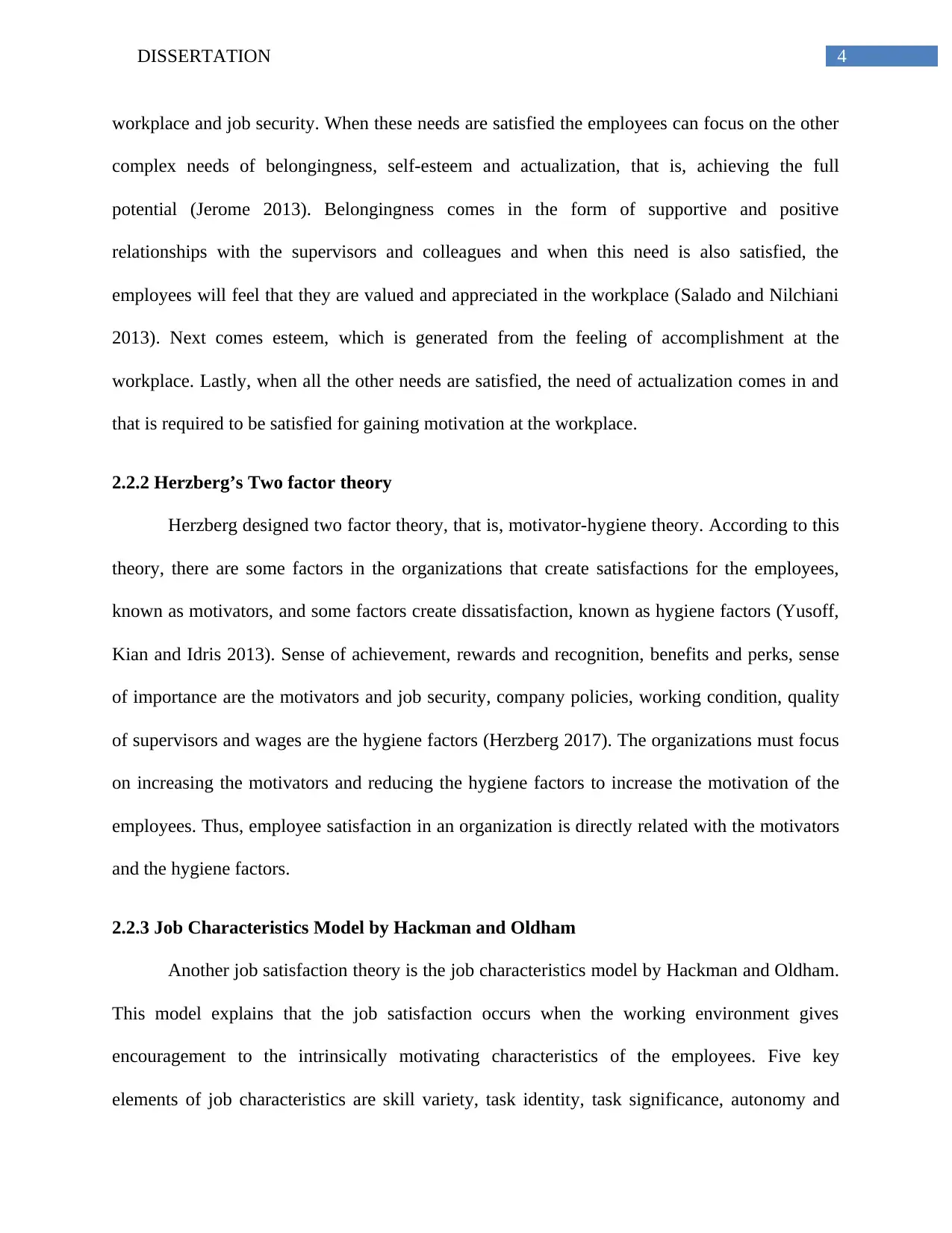
4DISSERTATION
workplace and job security. When these needs are satisfied the employees can focus on the other
complex needs of belongingness, self-esteem and actualization, that is, achieving the full
potential (Jerome 2013). Belongingness comes in the form of supportive and positive
relationships with the supervisors and colleagues and when this need is also satisfied, the
employees will feel that they are valued and appreciated in the workplace (Salado and Nilchiani
2013). Next comes esteem, which is generated from the feeling of accomplishment at the
workplace. Lastly, when all the other needs are satisfied, the need of actualization comes in and
that is required to be satisfied for gaining motivation at the workplace.
2.2.2 Herzberg’s Two factor theory
Herzberg designed two factor theory, that is, motivator-hygiene theory. According to this
theory, there are some factors in the organizations that create satisfactions for the employees,
known as motivators, and some factors create dissatisfaction, known as hygiene factors (Yusoff,
Kian and Idris 2013). Sense of achievement, rewards and recognition, benefits and perks, sense
of importance are the motivators and job security, company policies, working condition, quality
of supervisors and wages are the hygiene factors (Herzberg 2017). The organizations must focus
on increasing the motivators and reducing the hygiene factors to increase the motivation of the
employees. Thus, employee satisfaction in an organization is directly related with the motivators
and the hygiene factors.
2.2.3 Job Characteristics Model by Hackman and Oldham
Another job satisfaction theory is the job characteristics model by Hackman and Oldham.
This model explains that the job satisfaction occurs when the working environment gives
encouragement to the intrinsically motivating characteristics of the employees. Five key
elements of job characteristics are skill variety, task identity, task significance, autonomy and
workplace and job security. When these needs are satisfied the employees can focus on the other
complex needs of belongingness, self-esteem and actualization, that is, achieving the full
potential (Jerome 2013). Belongingness comes in the form of supportive and positive
relationships with the supervisors and colleagues and when this need is also satisfied, the
employees will feel that they are valued and appreciated in the workplace (Salado and Nilchiani
2013). Next comes esteem, which is generated from the feeling of accomplishment at the
workplace. Lastly, when all the other needs are satisfied, the need of actualization comes in and
that is required to be satisfied for gaining motivation at the workplace.
2.2.2 Herzberg’s Two factor theory
Herzberg designed two factor theory, that is, motivator-hygiene theory. According to this
theory, there are some factors in the organizations that create satisfactions for the employees,
known as motivators, and some factors create dissatisfaction, known as hygiene factors (Yusoff,
Kian and Idris 2013). Sense of achievement, rewards and recognition, benefits and perks, sense
of importance are the motivators and job security, company policies, working condition, quality
of supervisors and wages are the hygiene factors (Herzberg 2017). The organizations must focus
on increasing the motivators and reducing the hygiene factors to increase the motivation of the
employees. Thus, employee satisfaction in an organization is directly related with the motivators
and the hygiene factors.
2.2.3 Job Characteristics Model by Hackman and Oldham
Another job satisfaction theory is the job characteristics model by Hackman and Oldham.
This model explains that the job satisfaction occurs when the working environment gives
encouragement to the intrinsically motivating characteristics of the employees. Five key
elements of job characteristics are skill variety, task identity, task significance, autonomy and
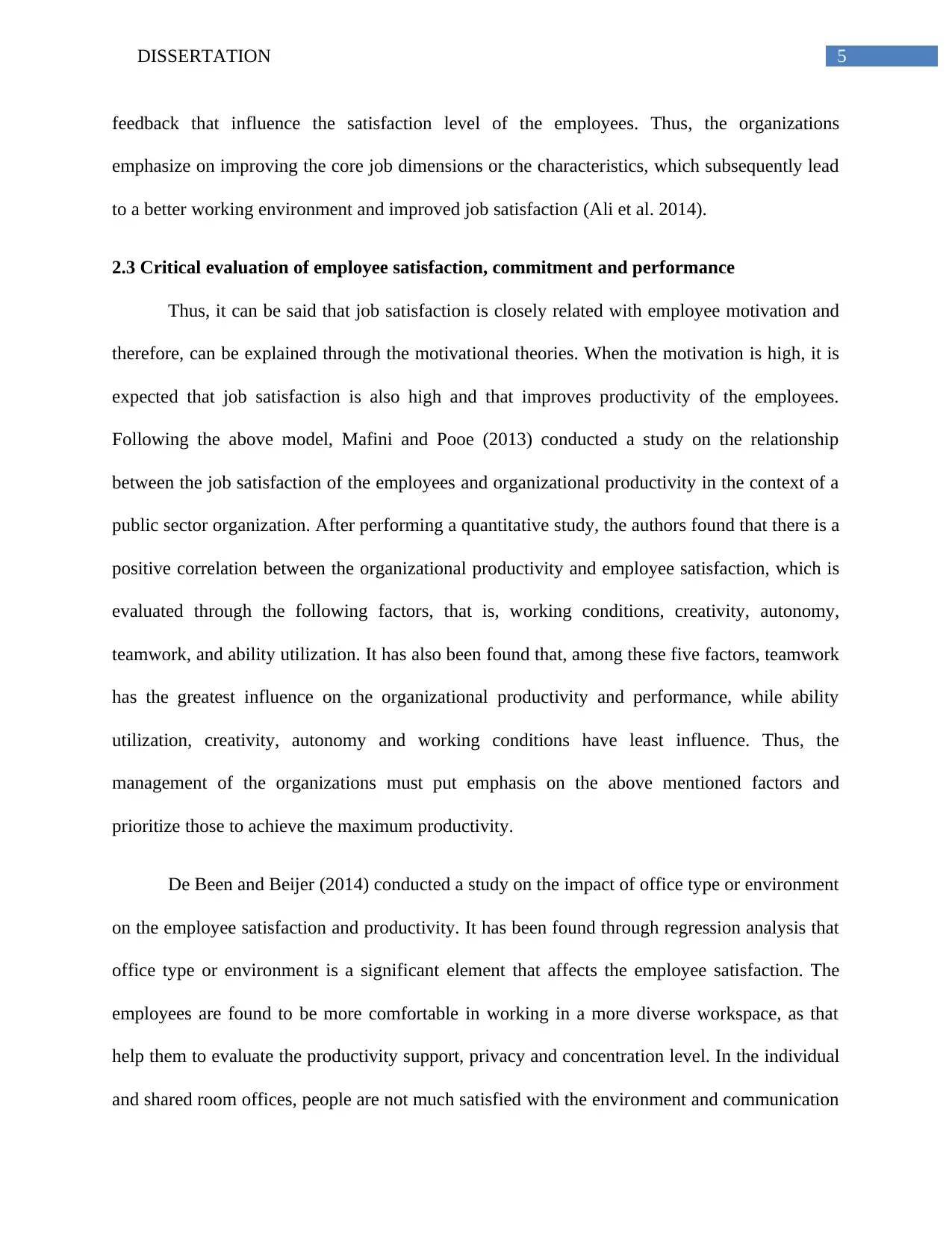
5DISSERTATION
feedback that influence the satisfaction level of the employees. Thus, the organizations
emphasize on improving the core job dimensions or the characteristics, which subsequently lead
to a better working environment and improved job satisfaction (Ali et al. 2014).
2.3 Critical evaluation of employee satisfaction, commitment and performance
Thus, it can be said that job satisfaction is closely related with employee motivation and
therefore, can be explained through the motivational theories. When the motivation is high, it is
expected that job satisfaction is also high and that improves productivity of the employees.
Following the above model, Mafini and Pooe (2013) conducted a study on the relationship
between the job satisfaction of the employees and organizational productivity in the context of a
public sector organization. After performing a quantitative study, the authors found that there is a
positive correlation between the organizational productivity and employee satisfaction, which is
evaluated through the following factors, that is, working conditions, creativity, autonomy,
teamwork, and ability utilization. It has also been found that, among these five factors, teamwork
has the greatest influence on the organizational productivity and performance, while ability
utilization, creativity, autonomy and working conditions have least influence. Thus, the
management of the organizations must put emphasis on the above mentioned factors and
prioritize those to achieve the maximum productivity.
De Been and Beijer (2014) conducted a study on the impact of office type or environment
on the employee satisfaction and productivity. It has been found through regression analysis that
office type or environment is a significant element that affects the employee satisfaction. The
employees are found to be more comfortable in working in a more diverse workspace, as that
help them to evaluate the productivity support, privacy and concentration level. In the individual
and shared room offices, people are not much satisfied with the environment and communication
feedback that influence the satisfaction level of the employees. Thus, the organizations
emphasize on improving the core job dimensions or the characteristics, which subsequently lead
to a better working environment and improved job satisfaction (Ali et al. 2014).
2.3 Critical evaluation of employee satisfaction, commitment and performance
Thus, it can be said that job satisfaction is closely related with employee motivation and
therefore, can be explained through the motivational theories. When the motivation is high, it is
expected that job satisfaction is also high and that improves productivity of the employees.
Following the above model, Mafini and Pooe (2013) conducted a study on the relationship
between the job satisfaction of the employees and organizational productivity in the context of a
public sector organization. After performing a quantitative study, the authors found that there is a
positive correlation between the organizational productivity and employee satisfaction, which is
evaluated through the following factors, that is, working conditions, creativity, autonomy,
teamwork, and ability utilization. It has also been found that, among these five factors, teamwork
has the greatest influence on the organizational productivity and performance, while ability
utilization, creativity, autonomy and working conditions have least influence. Thus, the
management of the organizations must put emphasis on the above mentioned factors and
prioritize those to achieve the maximum productivity.
De Been and Beijer (2014) conducted a study on the impact of office type or environment
on the employee satisfaction and productivity. It has been found through regression analysis that
office type or environment is a significant element that affects the employee satisfaction. The
employees are found to be more comfortable in working in a more diverse workspace, as that
help them to evaluate the productivity support, privacy and concentration level. In the individual
and shared room offices, people are not much satisfied with the environment and communication
⊘ This is a preview!⊘
Do you want full access?
Subscribe today to unlock all pages.

Trusted by 1+ million students worldwide
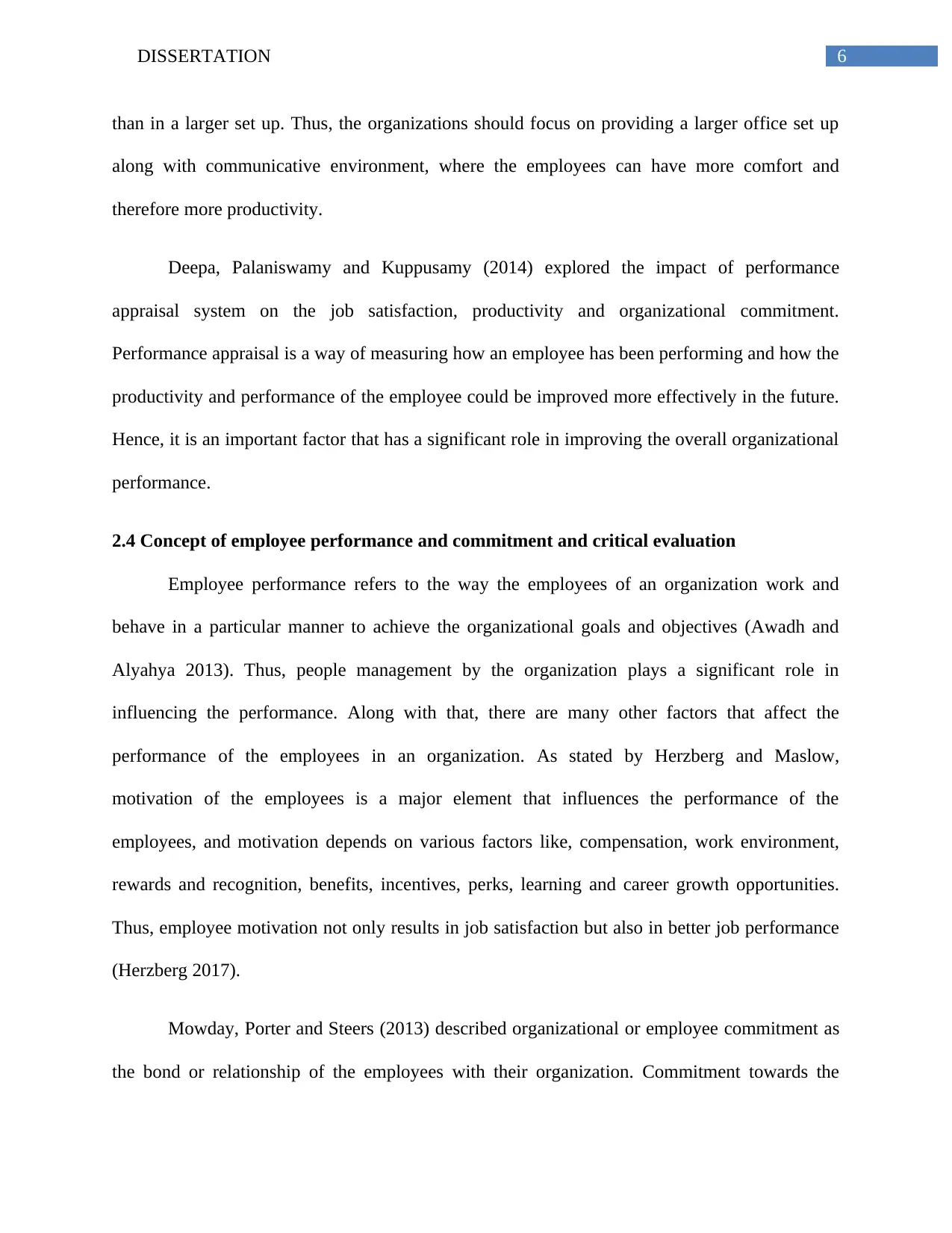
6DISSERTATION
than in a larger set up. Thus, the organizations should focus on providing a larger office set up
along with communicative environment, where the employees can have more comfort and
therefore more productivity.
Deepa, Palaniswamy and Kuppusamy (2014) explored the impact of performance
appraisal system on the job satisfaction, productivity and organizational commitment.
Performance appraisal is a way of measuring how an employee has been performing and how the
productivity and performance of the employee could be improved more effectively in the future.
Hence, it is an important factor that has a significant role in improving the overall organizational
performance.
2.4 Concept of employee performance and commitment and critical evaluation
Employee performance refers to the way the employees of an organization work and
behave in a particular manner to achieve the organizational goals and objectives (Awadh and
Alyahya 2013). Thus, people management by the organization plays a significant role in
influencing the performance. Along with that, there are many other factors that affect the
performance of the employees in an organization. As stated by Herzberg and Maslow,
motivation of the employees is a major element that influences the performance of the
employees, and motivation depends on various factors like, compensation, work environment,
rewards and recognition, benefits, incentives, perks, learning and career growth opportunities.
Thus, employee motivation not only results in job satisfaction but also in better job performance
(Herzberg 2017).
Mowday, Porter and Steers (2013) described organizational or employee commitment as
the bond or relationship of the employees with their organization. Commitment towards the
than in a larger set up. Thus, the organizations should focus on providing a larger office set up
along with communicative environment, where the employees can have more comfort and
therefore more productivity.
Deepa, Palaniswamy and Kuppusamy (2014) explored the impact of performance
appraisal system on the job satisfaction, productivity and organizational commitment.
Performance appraisal is a way of measuring how an employee has been performing and how the
productivity and performance of the employee could be improved more effectively in the future.
Hence, it is an important factor that has a significant role in improving the overall organizational
performance.
2.4 Concept of employee performance and commitment and critical evaluation
Employee performance refers to the way the employees of an organization work and
behave in a particular manner to achieve the organizational goals and objectives (Awadh and
Alyahya 2013). Thus, people management by the organization plays a significant role in
influencing the performance. Along with that, there are many other factors that affect the
performance of the employees in an organization. As stated by Herzberg and Maslow,
motivation of the employees is a major element that influences the performance of the
employees, and motivation depends on various factors like, compensation, work environment,
rewards and recognition, benefits, incentives, perks, learning and career growth opportunities.
Thus, employee motivation not only results in job satisfaction but also in better job performance
(Herzberg 2017).
Mowday, Porter and Steers (2013) described organizational or employee commitment as
the bond or relationship of the employees with their organization. Commitment towards the
Paraphrase This Document
Need a fresh take? Get an instant paraphrase of this document with our AI Paraphraser
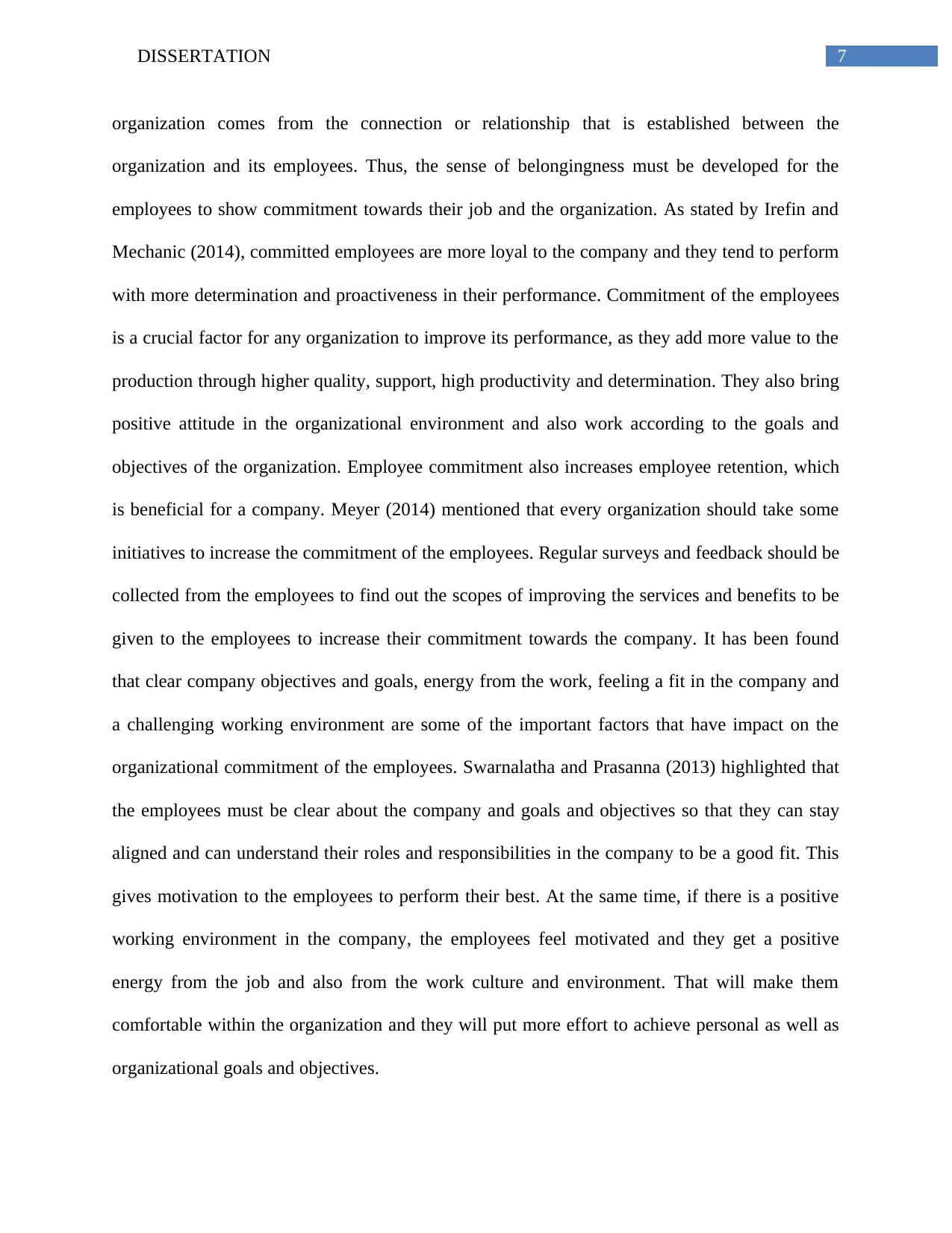
7DISSERTATION
organization comes from the connection or relationship that is established between the
organization and its employees. Thus, the sense of belongingness must be developed for the
employees to show commitment towards their job and the organization. As stated by Irefin and
Mechanic (2014), committed employees are more loyal to the company and they tend to perform
with more determination and proactiveness in their performance. Commitment of the employees
is a crucial factor for any organization to improve its performance, as they add more value to the
production through higher quality, support, high productivity and determination. They also bring
positive attitude in the organizational environment and also work according to the goals and
objectives of the organization. Employee commitment also increases employee retention, which
is beneficial for a company. Meyer (2014) mentioned that every organization should take some
initiatives to increase the commitment of the employees. Regular surveys and feedback should be
collected from the employees to find out the scopes of improving the services and benefits to be
given to the employees to increase their commitment towards the company. It has been found
that clear company objectives and goals, energy from the work, feeling a fit in the company and
a challenging working environment are some of the important factors that have impact on the
organizational commitment of the employees. Swarnalatha and Prasanna (2013) highlighted that
the employees must be clear about the company and goals and objectives so that they can stay
aligned and can understand their roles and responsibilities in the company to be a good fit. This
gives motivation to the employees to perform their best. At the same time, if there is a positive
working environment in the company, the employees feel motivated and they get a positive
energy from the job and also from the work culture and environment. That will make them
comfortable within the organization and they will put more effort to achieve personal as well as
organizational goals and objectives.
organization comes from the connection or relationship that is established between the
organization and its employees. Thus, the sense of belongingness must be developed for the
employees to show commitment towards their job and the organization. As stated by Irefin and
Mechanic (2014), committed employees are more loyal to the company and they tend to perform
with more determination and proactiveness in their performance. Commitment of the employees
is a crucial factor for any organization to improve its performance, as they add more value to the
production through higher quality, support, high productivity and determination. They also bring
positive attitude in the organizational environment and also work according to the goals and
objectives of the organization. Employee commitment also increases employee retention, which
is beneficial for a company. Meyer (2014) mentioned that every organization should take some
initiatives to increase the commitment of the employees. Regular surveys and feedback should be
collected from the employees to find out the scopes of improving the services and benefits to be
given to the employees to increase their commitment towards the company. It has been found
that clear company objectives and goals, energy from the work, feeling a fit in the company and
a challenging working environment are some of the important factors that have impact on the
organizational commitment of the employees. Swarnalatha and Prasanna (2013) highlighted that
the employees must be clear about the company and goals and objectives so that they can stay
aligned and can understand their roles and responsibilities in the company to be a good fit. This
gives motivation to the employees to perform their best. At the same time, if there is a positive
working environment in the company, the employees feel motivated and they get a positive
energy from the job and also from the work culture and environment. That will make them
comfortable within the organization and they will put more effort to achieve personal as well as
organizational goals and objectives.
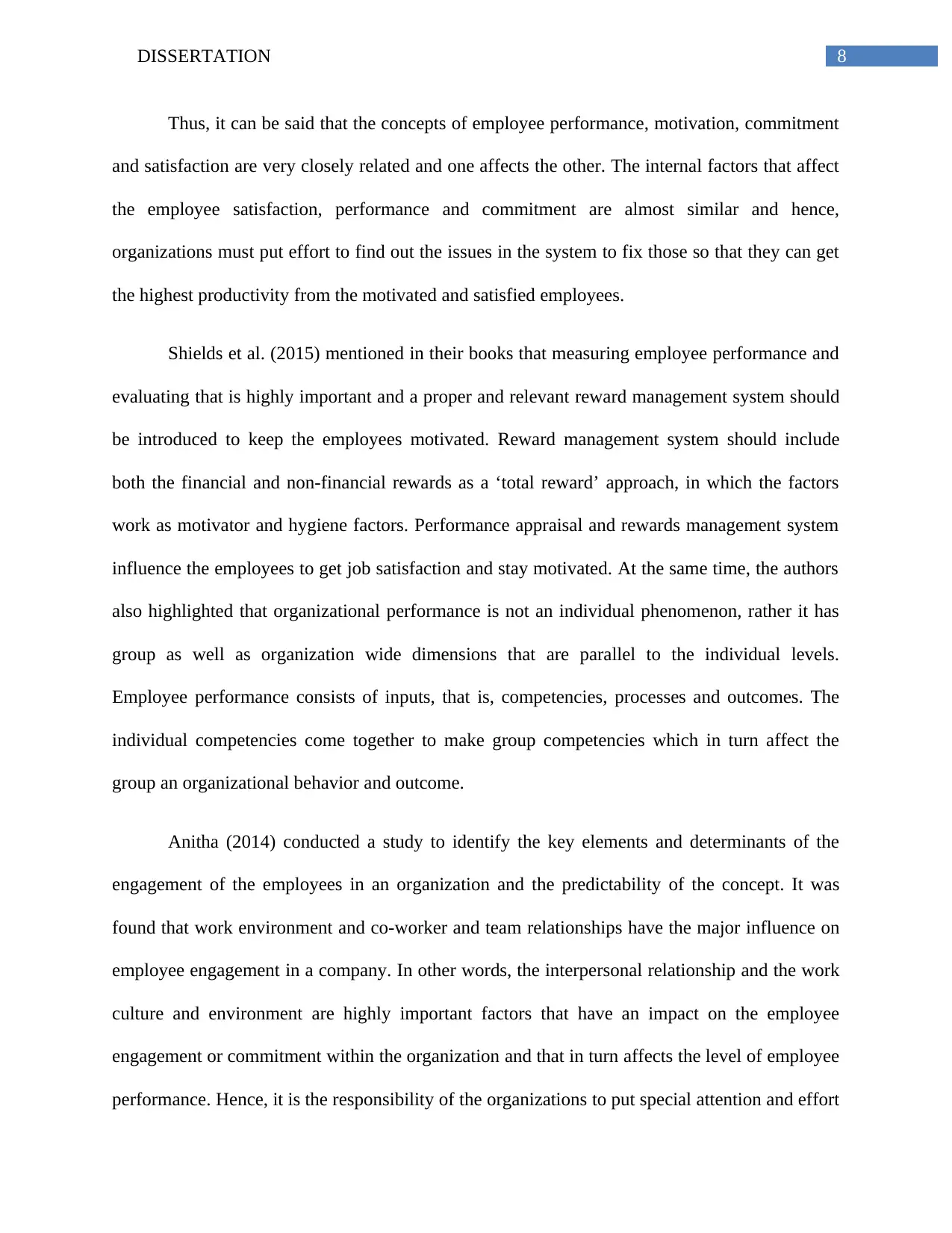
8DISSERTATION
Thus, it can be said that the concepts of employee performance, motivation, commitment
and satisfaction are very closely related and one affects the other. The internal factors that affect
the employee satisfaction, performance and commitment are almost similar and hence,
organizations must put effort to find out the issues in the system to fix those so that they can get
the highest productivity from the motivated and satisfied employees.
Shields et al. (2015) mentioned in their books that measuring employee performance and
evaluating that is highly important and a proper and relevant reward management system should
be introduced to keep the employees motivated. Reward management system should include
both the financial and non-financial rewards as a ‘total reward’ approach, in which the factors
work as motivator and hygiene factors. Performance appraisal and rewards management system
influence the employees to get job satisfaction and stay motivated. At the same time, the authors
also highlighted that organizational performance is not an individual phenomenon, rather it has
group as well as organization wide dimensions that are parallel to the individual levels.
Employee performance consists of inputs, that is, competencies, processes and outcomes. The
individual competencies come together to make group competencies which in turn affect the
group an organizational behavior and outcome.
Anitha (2014) conducted a study to identify the key elements and determinants of the
engagement of the employees in an organization and the predictability of the concept. It was
found that work environment and co-worker and team relationships have the major influence on
employee engagement in a company. In other words, the interpersonal relationship and the work
culture and environment are highly important factors that have an impact on the employee
engagement or commitment within the organization and that in turn affects the level of employee
performance. Hence, it is the responsibility of the organizations to put special attention and effort
Thus, it can be said that the concepts of employee performance, motivation, commitment
and satisfaction are very closely related and one affects the other. The internal factors that affect
the employee satisfaction, performance and commitment are almost similar and hence,
organizations must put effort to find out the issues in the system to fix those so that they can get
the highest productivity from the motivated and satisfied employees.
Shields et al. (2015) mentioned in their books that measuring employee performance and
evaluating that is highly important and a proper and relevant reward management system should
be introduced to keep the employees motivated. Reward management system should include
both the financial and non-financial rewards as a ‘total reward’ approach, in which the factors
work as motivator and hygiene factors. Performance appraisal and rewards management system
influence the employees to get job satisfaction and stay motivated. At the same time, the authors
also highlighted that organizational performance is not an individual phenomenon, rather it has
group as well as organization wide dimensions that are parallel to the individual levels.
Employee performance consists of inputs, that is, competencies, processes and outcomes. The
individual competencies come together to make group competencies which in turn affect the
group an organizational behavior and outcome.
Anitha (2014) conducted a study to identify the key elements and determinants of the
engagement of the employees in an organization and the predictability of the concept. It was
found that work environment and co-worker and team relationships have the major influence on
employee engagement in a company. In other words, the interpersonal relationship and the work
culture and environment are highly important factors that have an impact on the employee
engagement or commitment within the organization and that in turn affects the level of employee
performance. Hence, it is the responsibility of the organizations to put special attention and effort
⊘ This is a preview!⊘
Do you want full access?
Subscribe today to unlock all pages.

Trusted by 1+ million students worldwide
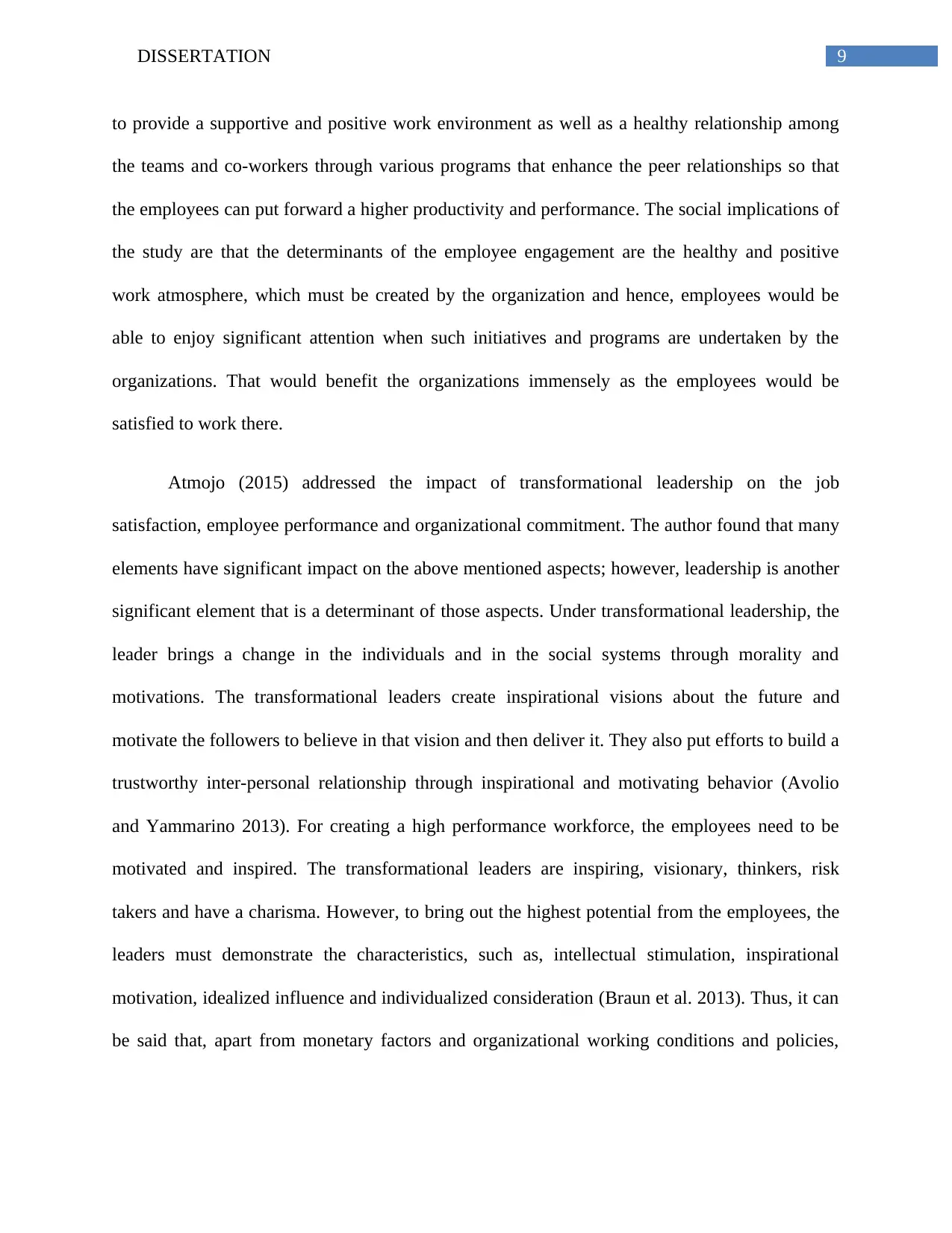
9DISSERTATION
to provide a supportive and positive work environment as well as a healthy relationship among
the teams and co-workers through various programs that enhance the peer relationships so that
the employees can put forward a higher productivity and performance. The social implications of
the study are that the determinants of the employee engagement are the healthy and positive
work atmosphere, which must be created by the organization and hence, employees would be
able to enjoy significant attention when such initiatives and programs are undertaken by the
organizations. That would benefit the organizations immensely as the employees would be
satisfied to work there.
Atmojo (2015) addressed the impact of transformational leadership on the job
satisfaction, employee performance and organizational commitment. The author found that many
elements have significant impact on the above mentioned aspects; however, leadership is another
significant element that is a determinant of those aspects. Under transformational leadership, the
leader brings a change in the individuals and in the social systems through morality and
motivations. The transformational leaders create inspirational visions about the future and
motivate the followers to believe in that vision and then deliver it. They also put efforts to build a
trustworthy inter-personal relationship through inspirational and motivating behavior (Avolio
and Yammarino 2013). For creating a high performance workforce, the employees need to be
motivated and inspired. The transformational leaders are inspiring, visionary, thinkers, risk
takers and have a charisma. However, to bring out the highest potential from the employees, the
leaders must demonstrate the characteristics, such as, intellectual stimulation, inspirational
motivation, idealized influence and individualized consideration (Braun et al. 2013). Thus, it can
be said that, apart from monetary factors and organizational working conditions and policies,
to provide a supportive and positive work environment as well as a healthy relationship among
the teams and co-workers through various programs that enhance the peer relationships so that
the employees can put forward a higher productivity and performance. The social implications of
the study are that the determinants of the employee engagement are the healthy and positive
work atmosphere, which must be created by the organization and hence, employees would be
able to enjoy significant attention when such initiatives and programs are undertaken by the
organizations. That would benefit the organizations immensely as the employees would be
satisfied to work there.
Atmojo (2015) addressed the impact of transformational leadership on the job
satisfaction, employee performance and organizational commitment. The author found that many
elements have significant impact on the above mentioned aspects; however, leadership is another
significant element that is a determinant of those aspects. Under transformational leadership, the
leader brings a change in the individuals and in the social systems through morality and
motivations. The transformational leaders create inspirational visions about the future and
motivate the followers to believe in that vision and then deliver it. They also put efforts to build a
trustworthy inter-personal relationship through inspirational and motivating behavior (Avolio
and Yammarino 2013). For creating a high performance workforce, the employees need to be
motivated and inspired. The transformational leaders are inspiring, visionary, thinkers, risk
takers and have a charisma. However, to bring out the highest potential from the employees, the
leaders must demonstrate the characteristics, such as, intellectual stimulation, inspirational
motivation, idealized influence and individualized consideration (Braun et al. 2013). Thus, it can
be said that, apart from monetary factors and organizational working conditions and policies,
Paraphrase This Document
Need a fresh take? Get an instant paraphrase of this document with our AI Paraphraser
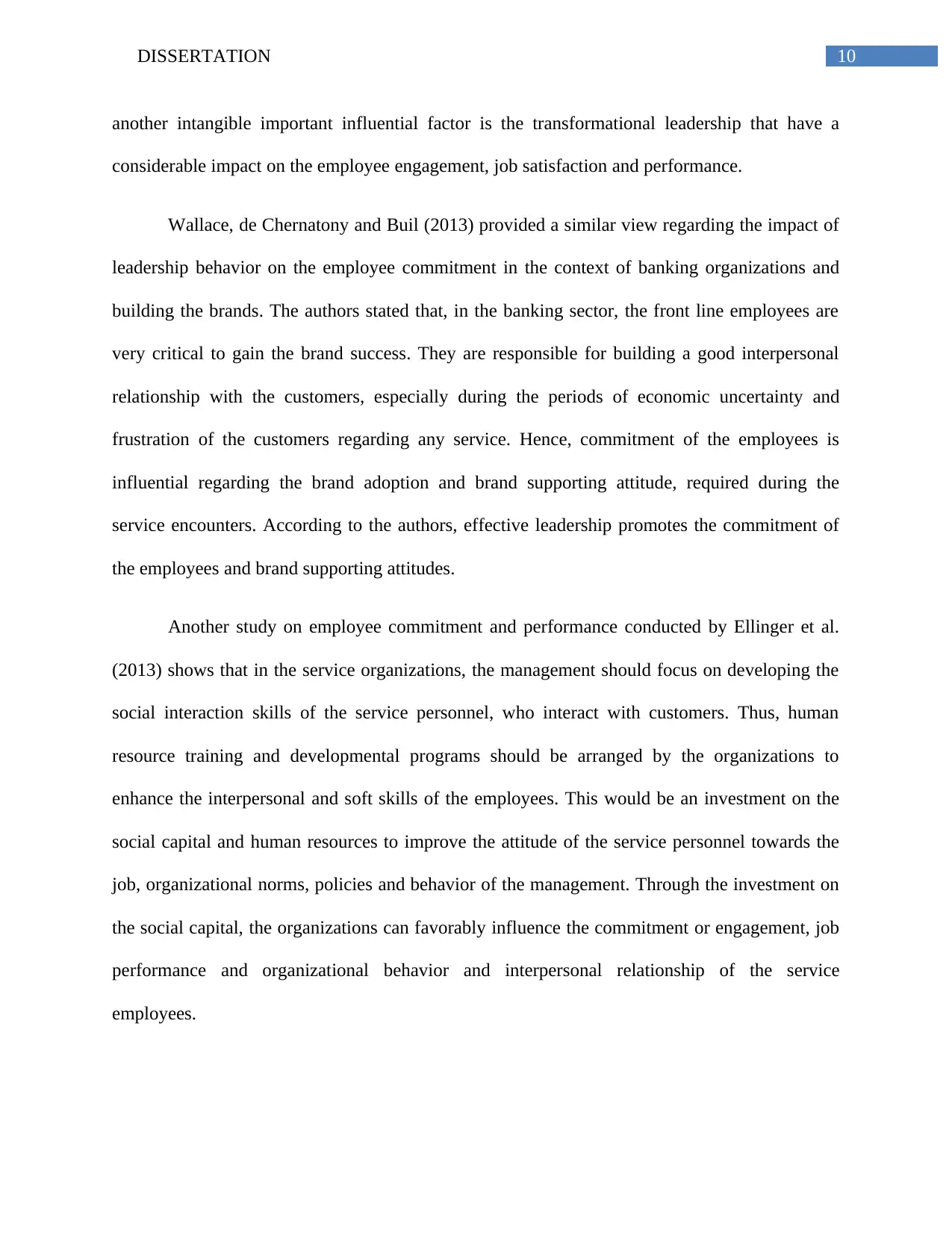
10DISSERTATION
another intangible important influential factor is the transformational leadership that have a
considerable impact on the employee engagement, job satisfaction and performance.
Wallace, de Chernatony and Buil (2013) provided a similar view regarding the impact of
leadership behavior on the employee commitment in the context of banking organizations and
building the brands. The authors stated that, in the banking sector, the front line employees are
very critical to gain the brand success. They are responsible for building a good interpersonal
relationship with the customers, especially during the periods of economic uncertainty and
frustration of the customers regarding any service. Hence, commitment of the employees is
influential regarding the brand adoption and brand supporting attitude, required during the
service encounters. According to the authors, effective leadership promotes the commitment of
the employees and brand supporting attitudes.
Another study on employee commitment and performance conducted by Ellinger et al.
(2013) shows that in the service organizations, the management should focus on developing the
social interaction skills of the service personnel, who interact with customers. Thus, human
resource training and developmental programs should be arranged by the organizations to
enhance the interpersonal and soft skills of the employees. This would be an investment on the
social capital and human resources to improve the attitude of the service personnel towards the
job, organizational norms, policies and behavior of the management. Through the investment on
the social capital, the organizations can favorably influence the commitment or engagement, job
performance and organizational behavior and interpersonal relationship of the service
employees.
another intangible important influential factor is the transformational leadership that have a
considerable impact on the employee engagement, job satisfaction and performance.
Wallace, de Chernatony and Buil (2013) provided a similar view regarding the impact of
leadership behavior on the employee commitment in the context of banking organizations and
building the brands. The authors stated that, in the banking sector, the front line employees are
very critical to gain the brand success. They are responsible for building a good interpersonal
relationship with the customers, especially during the periods of economic uncertainty and
frustration of the customers regarding any service. Hence, commitment of the employees is
influential regarding the brand adoption and brand supporting attitude, required during the
service encounters. According to the authors, effective leadership promotes the commitment of
the employees and brand supporting attitudes.
Another study on employee commitment and performance conducted by Ellinger et al.
(2013) shows that in the service organizations, the management should focus on developing the
social interaction skills of the service personnel, who interact with customers. Thus, human
resource training and developmental programs should be arranged by the organizations to
enhance the interpersonal and soft skills of the employees. This would be an investment on the
social capital and human resources to improve the attitude of the service personnel towards the
job, organizational norms, policies and behavior of the management. Through the investment on
the social capital, the organizations can favorably influence the commitment or engagement, job
performance and organizational behavior and interpersonal relationship of the service
employees.
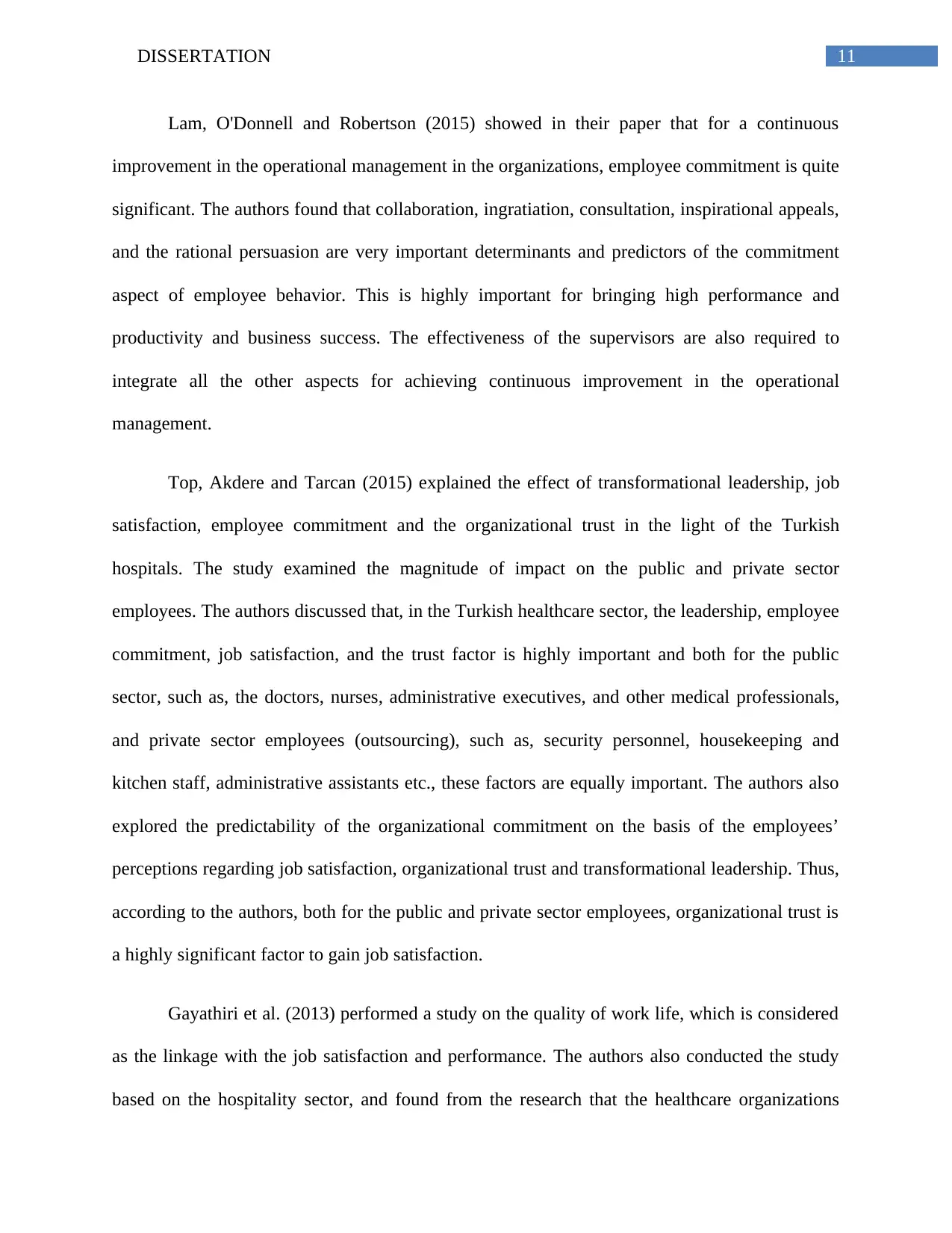
11DISSERTATION
Lam, O'Donnell and Robertson (2015) showed in their paper that for a continuous
improvement in the operational management in the organizations, employee commitment is quite
significant. The authors found that collaboration, ingratiation, consultation, inspirational appeals,
and the rational persuasion are very important determinants and predictors of the commitment
aspect of employee behavior. This is highly important for bringing high performance and
productivity and business success. The effectiveness of the supervisors are also required to
integrate all the other aspects for achieving continuous improvement in the operational
management.
Top, Akdere and Tarcan (2015) explained the effect of transformational leadership, job
satisfaction, employee commitment and the organizational trust in the light of the Turkish
hospitals. The study examined the magnitude of impact on the public and private sector
employees. The authors discussed that, in the Turkish healthcare sector, the leadership, employee
commitment, job satisfaction, and the trust factor is highly important and both for the public
sector, such as, the doctors, nurses, administrative executives, and other medical professionals,
and private sector employees (outsourcing), such as, security personnel, housekeeping and
kitchen staff, administrative assistants etc., these factors are equally important. The authors also
explored the predictability of the organizational commitment on the basis of the employees’
perceptions regarding job satisfaction, organizational trust and transformational leadership. Thus,
according to the authors, both for the public and private sector employees, organizational trust is
a highly significant factor to gain job satisfaction.
Gayathiri et al. (2013) performed a study on the quality of work life, which is considered
as the linkage with the job satisfaction and performance. The authors also conducted the study
based on the hospitality sector, and found from the research that the healthcare organizations
Lam, O'Donnell and Robertson (2015) showed in their paper that for a continuous
improvement in the operational management in the organizations, employee commitment is quite
significant. The authors found that collaboration, ingratiation, consultation, inspirational appeals,
and the rational persuasion are very important determinants and predictors of the commitment
aspect of employee behavior. This is highly important for bringing high performance and
productivity and business success. The effectiveness of the supervisors are also required to
integrate all the other aspects for achieving continuous improvement in the operational
management.
Top, Akdere and Tarcan (2015) explained the effect of transformational leadership, job
satisfaction, employee commitment and the organizational trust in the light of the Turkish
hospitals. The study examined the magnitude of impact on the public and private sector
employees. The authors discussed that, in the Turkish healthcare sector, the leadership, employee
commitment, job satisfaction, and the trust factor is highly important and both for the public
sector, such as, the doctors, nurses, administrative executives, and other medical professionals,
and private sector employees (outsourcing), such as, security personnel, housekeeping and
kitchen staff, administrative assistants etc., these factors are equally important. The authors also
explored the predictability of the organizational commitment on the basis of the employees’
perceptions regarding job satisfaction, organizational trust and transformational leadership. Thus,
according to the authors, both for the public and private sector employees, organizational trust is
a highly significant factor to gain job satisfaction.
Gayathiri et al. (2013) performed a study on the quality of work life, which is considered
as the linkage with the job satisfaction and performance. The authors also conducted the study
based on the hospitality sector, and found from the research that the healthcare organizations
⊘ This is a preview!⊘
Do you want full access?
Subscribe today to unlock all pages.

Trusted by 1+ million students worldwide
1 out of 35
Related Documents
Your All-in-One AI-Powered Toolkit for Academic Success.
+13062052269
info@desklib.com
Available 24*7 on WhatsApp / Email
![[object Object]](/_next/static/media/star-bottom.7253800d.svg)
Unlock your academic potential
Copyright © 2020–2025 A2Z Services. All Rights Reserved. Developed and managed by ZUCOL.





